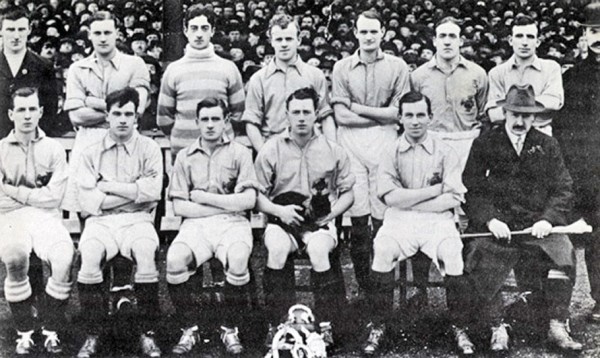
In a World Cup year, conversation will often turn to the question of who were the greatest footballers ever to have played for Ireland. Debate can be fierce, and everyone will have their own choice of those who should or should not be regarded as Ireland’s finest.
John Giles, Liam Brady, and Ronnie Whelan will certainly be among those regularly chosen, and few of us would argue with their selection, but ask the wise football men of Ringsend and you will always hear another name mentioned, a name from the far and distant past: Val Harris.
Valentine ‘Val’ Harris was born in 1884. He was a star player for his country and his club, for the Ireland team and for Shelbourne FC. He was a winner, earning silverware and bringing home glory to Ringsend and Ireland football.
He played his last match for Ireland one hundred years ago in 1914, but still, all these years later, in Ringsend and beyond, his legend lives on.
Stories of his deeds have been handed down from grandfather to father to son. He was hard, they say, he was strong, and powerful. Of course, it is not possible to analyse video footage of him in action, but the stories conjure vivid images of the player he was. They tell of the characteristics he shared with some more recent men in green.
You can picture him winning the ball with a clattering, reverberating tackle, a Kevin Moran special. You can see him nearly bursting his lungs, covering every blade of grass on the pitch and controlling the game with the authority of Roy Keane at his peak. You can imagine him marshalling the back line, and sensing danger, with the uncannily accurate anticipation and defensive instinct of Paul McGrath.
The records show that Val Harris also had the ability to conjure vital goals at just the moments they were most needed. Testimony from his own era tells us of a football master, who excelled for club and country in all areas of the field.
For Ireland, he filled multiple roles, playing in five different positions during his 20 appearances. He started out as a forward and ended up as a defender in internationals, and was occasionally criticised for his lack of goals. However, whether playing in defence or attack, he usually spent games marking the opposition’s top player. His consistently high levels of play, and his importance to his team, made him a target for the opposition, and this, along with his combative and physical style of play, resulted in many severe injuries during his career.
On three occasions he was believed to have been finished as a player, due to the severity of his injuries, but each time he battled back to play another day.
When fit he was an automatic starter for Ireland, making 13 consecutive appearances. This run included, in 1913, victory against Scotland, two wins versus Wales, as well as Ireland’s first-ever victory over England. On that occasion he captained the side to a 2-1 win in Belfast. These successes came at a time when it was rare for Ireland to win any games.
Then, in his final year as an international, he starred in what remains one of the finest achievements in our soccer history. This came when, in 1914, Ireland won the British Home Championship for the first time.
Val Harris earned a total of 20 caps, during an era when Ireland played no more than three international matches each season. Additionally, it was a time when the Belfast-based Irish Football Association showed a consistent and deep reluctance to select Ireland players from the south of the country. The fact that Harris overcame these factors to become a regular helps to illustrate his huge value to the Ireland team.
He was also a bona fide star for Ringsend’s local football club, Shelbourne FC. Signed by Shels in 1903, he went on to set records for most appearances (36), and most goals (12) in the IFA Cup by a Shelbourne player.
He was the first Shels player capped for Ireland, winning six of his Ireland caps while with the club, between 1906 and 1908, and remains the club’s most capped player. A key player in the Shels teams that reached four straight IFA Cup finals during that same period, he captained the side to the victory in 1906 that saw them become the first Dublin club to win the trophy. In four of those finals he displayed that famous versatility of his, playing in three different positions for the team. In 1905 and 1906 he played centre-forward, 1907 he was on the wing at outside-right and, in the last of that run in 1908, he lined out at right-half.
After a successful stint in English first division football, following his transfer to Everton FC in 1908, Harris returned to Shels in 1914. He remained at the club until his retirement in 1927. During his later years, the Reds won the IFA Cup again in 1920. In 1921, the club was a founder member of the Free State League. In 1926, well past his fortieth birthday, Harris earned his final honour as a player, as Shels won the new league for the first time.
On his retirement from playing in 1927, he became the manager of Shelbourne and of the Irish Free State international side. Later he would seal, beyond any shadow of doubt, his status as a Shelbourne legend when, in 1939, he guided the club to their first victory in an FAI Cup final.
His first home was at Clarence Place off Macken Street, and more than a century has passed since he was born, but he is still revered locally in Dublin and beyond as a true football hero. I feel sure that after another century has passed, valiant Val Harris will still be remembered as one of the greats.
Pictured: Val Harris, top row, second from right.
By Gavan Bergin

